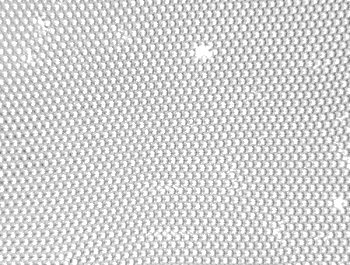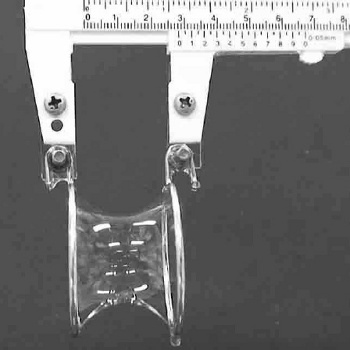Soap Films
April 28, 2011
Computers are nice for modeling
physical systems, but sometimes the model is so complex that a genral purpose computer isn't up to the task. One approach for surmounting this complexity is to advance your
computer architecture, adding things such as
parallelism and
vector processing; or pumping up the hardware via
clusters, or the many "
@home" projects.
There was a time when
scientists didn't have computers. Instead of sitting on their hands (see my
previous article, Everything Becomes Trivial, March 25, 2011), they were as inventive as ever in making
models using physical objects. I was introduced to this idea during my senior year of
high school while taking
PSSC Physics. This physics course was part of the US answer to the shortage of scientists and
engineers during our
competition with the Russians.
PSSC Physics had some very nice
laboratory modules associated with it. One
experiment that caught my fancy was a simple way to measure the Earth's
gravitational acceleration g. Another experiment involved the
ripple tank, a shallow tank of
water with a
plane wave generator at one end. The ripple tank allowed visualization of
optical effects, including the famous
double slit experiment. The ripple tank was a physical model of wave interference.
Long before my ripple tank experiments, in fact the year I was born, a
Nobel Laureate was playing with
soap bubbles in the name of science.
Sir William Lawrence Bragg, well known for the eponymous
Bragg' Law, and
John Nye were using rafts of bubbles on liquid surfaces to simulate
atoms in
crystals.[1-2] The duo found that
glycerin-
oleic acid-
triethanolamine-water solutions form small, stable bubbles.
Bragg and Nye used bubble rafts to demonstrate
dislocations and their reactions. In an example of
Louis Pasteur's quotation that "chance favors the prepared mind," Bragg supposedly had the idea of the bubble raft while observing the bubbles formed when he was adding
oil to a lawn mower.[2] Maybe that's an incentive for me to mow my lawn.

A bubble raft from a laboratory class at MIT. This raft has bubbles that are about 1.5 mm in diameter. An edge dislocation (an inserted row of bubbles) can be seen in the lower right hand quadrant.
(Photo by Vlad Tarasov, via Wikimedia Commons, modified)
Recently, two researchers at the
University of Málaga, Spain, used soap films to solve
variational mathematical problems that appear in many physical systems.[3-4] Soap films can be used for such modeling since they always form with a shape that minimizes their
elastic energy and area.[5]
Examples of variational problems are the
brachistochrone and
catenary equations. The former is the shape that a wire must have for a threaded ball to travel its length as rapidly as possible; the later is the shape of a rope or chain suspended at its ends. There's also the
isoperimetric curve, which maximizes the area it encloses. The Spanish researchers found that such equations can be simulated by adjusting the
boundary conditions of a soap film.
There have been other demonstrations of using soap films to investigate
geometrical objects. In one case, as shown in the figure, soap film
catenoids were formed between coaxial rings. The catenoid shape was monitored as a function of the distance between the rings.[6]

A soap film catenoid contained between two coaxial circular rings.
(Via arXiv. Fig. 4 of Ref. 6)
A
Möbius loop can be formed by a soap film on a looped wire. One study investigated how wire deformation can cause a transition of a soap film from the one-sided Möbius loop
topology to a two-sided film.[7-8] A wire bent into a double loop will support a soap film Möbius loop, but when the loop is untwisted, the soap film reverts to a two-sided topology. A video of the transition appears on the
Proceedings of the National Academy of Science web site.[9]
Bubbles serve more than just science. On Friday, April 15, 2011, an attempt was made to enter the
Guinness Book of World Records by having 37,000 people blow soap bubbles. This was the 8th Annual Blow Bubbles 4
Autism event organized by the southern
New Jersey FACES Autism Support Network.[10] The
present Guinness record is 34,259 people at 198 locations.
References:
- L. Bragg, L. and J.F. Nye, "A Dynamical Model of a Crystal Structure," Proc. R. Soc. Lond. A, 190, no. 1023 (September 9, 1947), pp. 474-481
- Bubble Rafts page on Wikipedia.
- Soap films help to solve mathematical problems, Spanish Foundation for Science and Technology Press Release, January 26, 2011.
- C. Criado and N. Alamo, "Solving the brachistochrone and other variational problems with soap films," American Journal of Physics, vol. 78, no. 12 (December, 2010), pp. 1400-1405.
- Mathematical aspects of soap bubble (Wikipedia).
- Masato Ito and Taku Sato, "In-situ observation of a soap film catenoid - a simple educational physics experiment," arXiv Preprint Server, December 22, 2009.
- Raymond E. Goldstein, H. Keith Moffatt, Adriana I. Pesci and Renzo L. Ricca, "Soap-film Möbius strip changes topology with a twist singularity," Proc. Natl. Acad. Sci., vol. 107, no. 51 (December 21, 2010), pp. 21979-21984.
- Charles Day, "Moebius soap films," Physics Today Blog, December 6, 2010
- Movie supplement for Ref. 7.
- Michelle Brunetti, "Ventnor-based autism support group prepares for another shot at bubble record," Press of Atlantic City, April 11, 2011.
- Soap Films Web Site by "Naveh"
Permanent Link to this article
Linked Keywords: Computer; physical system; computer architecture; parallel computing; vector processing; computer clusters; Berkeley Open Infrastructure for Network Computing; @home; scientist; scientific modelling; high school; PSSC Physics; engineer; Space Race; laboratory; experiment; gravitational acceleration; ripple tank; water; plane wave; optics; double slit; Nobel Prize in Physics; Nobel Laureate; soap bubbles; Sir William Lawrence Bragg; Bragg' Law; John Nye; atoms; crystal; glycerol; oleic acid; triethanolamine; dislocation; Louis Pasteur; oil; Vlad Tarasov; Wikimedia Commons; Málaga; Spain; calculus of variations; elastic energy; brachistochrone; catenary; isoperimetric curve; boundary condition; geometry; catenoid; arXiv; Möbius loop; topology; Proceedings of the National Academy of Science.